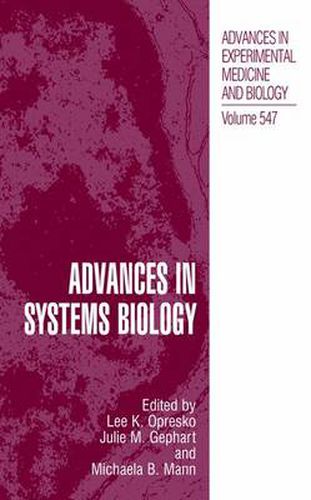Readings Newsletter
Become a Readings Member to make your shopping experience even easier.
Sign in or sign up for free!
You’re not far away from qualifying for FREE standard shipping within Australia
You’ve qualified for FREE standard shipping within Australia
The cart is loading…






This title is printed to order. This book may have been self-published. If so, we cannot guarantee the quality of the content. In the main most books will have gone through the editing process however some may not. We therefore suggest that you be aware of this before ordering this book. If in doubt check either the author or publisher’s details as we are unable to accept any returns unless they are faulty. Please contact us if you have any questions.
AbouttheNorthwestSymposiumforSystemsBiology This publication is the proceedingsofthe Pacific Northwest National Laboratory (PNNL) inaugural meeting of the Northwest Symposium for Systems Biology, held October 17 and 18,2002, in Richland, Washington. This is the40thyear in which the laboratory has held an interdisciplinary science symposium to address important biologicalquestions. Inyearspast,theunifyingthemewasenvironmentalsciences.This yearwebegananewseriesofsymposiaonsystemsbiology.Aparticularfocusofthese symposiawill beon identifyingcurrentbreakthroughtechnologiesand theirapplication toimportantmodelsystems. PNNLestablished theBiomolecularSystemsInitiative(BSI) toexploit the unique andinnovativetechnologiesdevelopedhereatthelaboratory,especiallyattheWilliamR. Wiley Environmental Molecular Sciences Laboratory (EMSL). The BSI is a multidisciplinary research program thatfocuses on theareasofresearch that will drive biology in the post-genomic era. It combines cutting-edge capabilities for high- throughputproteomics,cellimaging,quantitativebiology,andcomputationalbiology. To understand complex biological systems, scientists must acquire detailed knowledgeaboutcellsignaling,andabouthownetworksregulatecellfunctions.Thiswill requireanintegratedeffortacrossavarietyofresearchdisciplines:molecularandcellular biology, biochemistry, physics, mathematics, and information science. The BSI is working to provide opportunities for scientists from different disciplines to gatherand discusscell networksatallscalesaswell asapproachesforunderstandingthemolecular componentsofthesenetworks. The theme of this year’s symposium was the U.S. Department ofEnergy’s new Genomes to Life (GTL) program. GTL has the eventual goal of a fundamental, comprehensive,andsystematicunderstandingoflife. In its initial implementation,GTL focusesonpost-genomicapproachestounderstanding * ComplexMicrobialSystems * ComputationalMethods * MolecularMachines:Multiproteincomplexes * GeneRegulatoryNetworks.
$9.00 standard shipping within Australia
FREE standard shipping within Australia for orders over $100.00
Express & International shipping calculated at checkout
This title is printed to order. This book may have been self-published. If so, we cannot guarantee the quality of the content. In the main most books will have gone through the editing process however some may not. We therefore suggest that you be aware of this before ordering this book. If in doubt check either the author or publisher’s details as we are unable to accept any returns unless they are faulty. Please contact us if you have any questions.
AbouttheNorthwestSymposiumforSystemsBiology This publication is the proceedingsofthe Pacific Northwest National Laboratory (PNNL) inaugural meeting of the Northwest Symposium for Systems Biology, held October 17 and 18,2002, in Richland, Washington. This is the40thyear in which the laboratory has held an interdisciplinary science symposium to address important biologicalquestions. Inyearspast,theunifyingthemewasenvironmentalsciences.This yearwebegananewseriesofsymposiaonsystemsbiology.Aparticularfocusofthese symposiawill beon identifyingcurrentbreakthroughtechnologiesand theirapplication toimportantmodelsystems. PNNLestablished theBiomolecularSystemsInitiative(BSI) toexploit the unique andinnovativetechnologiesdevelopedhereatthelaboratory,especiallyattheWilliamR. Wiley Environmental Molecular Sciences Laboratory (EMSL). The BSI is a multidisciplinary research program thatfocuses on theareasofresearch that will drive biology in the post-genomic era. It combines cutting-edge capabilities for high- throughputproteomics,cellimaging,quantitativebiology,andcomputationalbiology. To understand complex biological systems, scientists must acquire detailed knowledgeaboutcellsignaling,andabouthownetworksregulatecellfunctions.Thiswill requireanintegratedeffortacrossavarietyofresearchdisciplines:molecularandcellular biology, biochemistry, physics, mathematics, and information science. The BSI is working to provide opportunities for scientists from different disciplines to gatherand discusscell networksatallscalesaswell asapproachesforunderstandingthemolecular componentsofthesenetworks. The theme of this year’s symposium was the U.S. Department ofEnergy’s new Genomes to Life (GTL) program. GTL has the eventual goal of a fundamental, comprehensive,andsystematicunderstandingoflife. In its initial implementation,GTL focusesonpost-genomicapproachestounderstanding * ComplexMicrobialSystems * ComputationalMethods * MolecularMachines:Multiproteincomplexes * GeneRegulatoryNetworks.